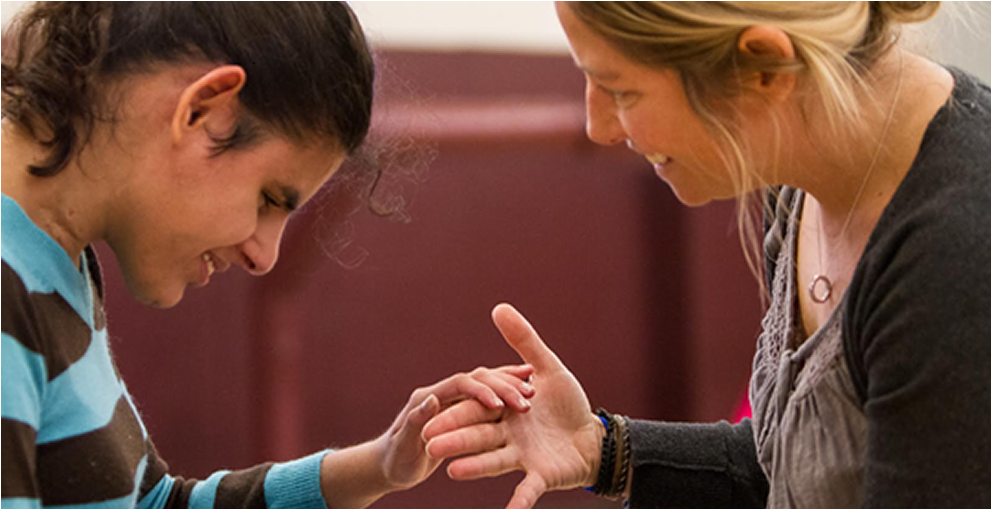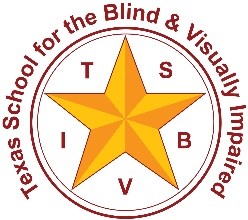Topical Resources

Fortunately, there are many, many wonderful resources on specific topics related to deafblindness and deafblind education. It is not our intent to list them all. Instead we offer a “reader’s digest” of articles that will help to get you started in learning more. Many of these products was developed by staff at Texas School for the Blind & Visually Impaired Outreach, but some are favorites of our staff developed by other colleagues with other deafblind projects and other agencies in the USA, and other locations. Under many of the other sections on this website we include material for taking a deeper dive into a specific topic; we hope you will explore these as well.
Our plan is to add to these topical resources regularly; so we encourage you to return to this section often to find new content.
Active Learning
Assessment Tools
- Appropriate Assessment Strategies: NCDB Practice Guide
- Assessing Communication and Learning in Children who are Deafblind or have Multiple Disabilities
- Assessment of Biobehavioral States: Supporting Availability for Learning for Students with Multiple Disabilities including Deafblindness & Profound Intellectual & Multiple Disabilities
- Assessment of Deafblind Access to Manual Language Systems (ADAMLS)
- Assessment Matrix for Students who are Deafblind
- Authentic Assessment
- Basic Infused Skills Assessment
- Communication Matrix
- Communication Matrix: What Is It & How Do I Use It Handout
- Early Tactile Learning Profile
- Essential Tools of the Trade for Teachers of Students who are Deafblind
- Functional Scheme Assessment (on Active Learning Space)
- Informal Functional Hearing Evaluation (IFHE)
- HomeTalk: A Family assessment of Children who are Deafblind
- Home Inventory of Problem Solving Skills
- The Oregon Project Curriculum and Skills Inventory
- School Inventory of Problem Solving Skills
- Sensory Learning Summary
- Summary of Deafblind Specific Evaluation Tools
Tools to Address Assessment and Instruction for Students with the Most Significant Challenges
Deafblind General Information
- Building Trusting Relationships: NCDB Practice Guide
- Deafblind Fact Sheet: Etiologies Related to Deafblindness
- Hand Under Hand Technique: NCDB Practice Guide
- Impact of Deafblindness on Learning
- Optimizing Availability for Learning: NCDB Practice Guide
- Overview on Deafblindness
- Preparing the Learning Environment: NCDB Practice Guide
Early Childhood
- Active Learning Space
- Brain Architecture- Center on the Developing Child, Harvard University
- Connected Baby: Bringing the Science of Connection to Life, Dr. Suzanne Zeedyk
- Early Childhood: Beginning to Use an Object Calendar
- Early Concept Development
- Early Identification and Self-Assessment Guide
- Early Identification of Hearing and Vision Loss Is Critical to a Child’s Development
- Federal Requirements for Transition from Part C to Preschool
- Impact of Visual Impairment On Development
- INSITE Curriculum
- Language Rich Environments for Children who are Deaf or Deafblind
- Oregon Project Curriculum and Skills Inventory
- Orientation and Mobility: Preschool Style
- Orientation and Mobility: The Early Years of Infancy Through Preschool
- Resilience- Center on the Developing Child, Harvard University
- Serve and Return- Center on the Developing Child, Harvard University
- Talking the Language of the Hands to the Hands
- The Sooner the Better: A Framework for Training Early Intervention Practitioners on Deaf-Blindness
Educational Considerations
- A Classroom Environment Checklist for Students Who Are Deafblind
- Active Learning Space
- Classroom Observation Instrument for Educational Environments Serving Students with Deaf-Blindness
- Expanded Core Curriculum Considerations for Students who are Deafblind
- Hand Under Hand Technique Practice Guide- NCDB
- IEP Quality Indicators for Students who are Deafblind
- Interpreter, Intervener, Co-Navigator/Support Service Provider…What’s the Difference?
- Language Rich Environments for Children who are Deaf or Deafblind
- Understanding the Expanded Core Curriculum – Perkins School for the Blind
- Literacy for Children with Combined Vision and Hearing Loss
- Minimal Losses…Major Implications
- New Practice Guides from National Center on Deaf-Blindness
- Nordic Welfare Center
- Paths to Literacy
- Supporting Communication for Children who are Deafblind Article
- Texas Deafblind Child Count
Fact Sheets
Family Engagement
Meet Your Family Organizations for the Blind, Low Vision, and Deafblind Communities
- DeafBlind Camp of Texas
- Deaf-Blind Multihandicapped Association of Texas (DBMAT)
- Family Advocacy Strategies– Lanya McKittrick
- Family Advocacy Strategies in Spanish– Lanya McKittrick
- National Family Association for Deaf-Blind
- National Center on Deaf-Blindness For Families Page
- National Initiatives on Family Engagement
- Navigate Life Texas website
- Parent Companion – the first five years website
- Partners Resource Network
- Texas Chargers
- Texas Hands & Voices
- Texas Project First website
- Value of Family Engagement: Identifying Unique Needs and Priorities of Families with Children Who Are Deaf-Blind Microsite
Hearing Loss
IEP Development Tools
- Determining the Need for an Intervener in Educational Settings
- Developing and IEP to Reflect Active Learning
- Guidance for Planning Behavior Intervention for Children and Young Adults who are Deafblind or have Visual and Multiple Impairments
- IEP Quality Indicators for Students who are Deafblind
- Lets Talk Deafblind Eligibility- FAQs and Their Answers
- Minimal Losses…Major Implications
- Specialization Knowledge and Skill Set for Paraeducators who are Interveners for Individuals with Deafblindness
- The Role of the Teacher of Students Who Are Deafblind in FIE Process
Individual and Family Perspectives
- 2017 TSBVI Commencement Speech: Living Life Expansively as a Blind Person in America
- A Family Story: Orion
- After Graduation Happenings
- A Mom on the Road to COMS
- Coming Home to Disability: One Sibling’s Story
- DeafBlind Camp of Texas Has a Successful Second Year
- Dear New Parents of a Deaf and Blind Child
- Discovering How to Connect and Communicate with My Granddaughter
- Fast Friends
- From Home, to School and Into the Community
- Futures Planning Led Us to Touch Base Center for the DeafBlind
- Going with the Flow: Supporting Henry’s Language Journey
- I Want You to Know: My Reflections on Publishing a Book
- My Success Story
- Texas Chargers: Our family’s journey to finding a community of support
- The Hardest Job of All: Acknowledging the Costs of Showing Up
- Touch That Cake!
- Transitions: “What Did You Say About Frogs”?: Deafblindness, An Incomplete Introduction
- What is ProTactile and What Are Its Benefits?
Orientation and Mobility
Proficient Communicators
- IEP Checklist for the Proficient Communicator
- IEP Checklist for the Proficient Communicator with Summaries
- Interpreter, Intervener, Co-Navigator/Support Service Provider…What’s the Difference?
- The Intervener’s Role – Facilitation Questions for the Proficient Communicator
- Let’s Talk Eligibility- FAQs and Their Answers
- The Intervener as Instructional Coach: For Students Who Are Deafblind In General Education Settings
- Understanding Concept Development and Related Challenges for Academic Students with DeafBlindness
Qualified Personnel for Individuals who are Deafblind:
- DeafBlind Intervener Specific Training
- Individualized Supports (Interveners, Service Support Providers, and Interpreters for individuals who are Deafblind):
- Open Hands Open Access Intervener Services Learning Modules
- Interveners in the Home and Community – An Under-recognized Imperative article
- The Intervener as Instructional Coach: For Students who are Deafblind in the General Education Setting
- OSEP Blog Interveners and Children who are Deafblind
- A Family’s Guide to Interveners – Download the booklet
- Determining the Need for an Intervener in Educational Settings
- Interpreter, Intervener, Co-Navigator/Support Service Provider…What’s the Difference?
- Orientation & Mobility Specialists
- Teachers of Students with Visual Impairments
- Teachers of Students who are Deaf/Hard of Hearing
- Teacher of Students who are Deafblind Standards for Texas
- The Teacher’s Role with the Intervener
Sexuality Education
Tactile Learning and Tactile Language
- If You Can See It, You Can Support It: a book about tactile language
- In Touch: Helping your blind child discover the world
- Tactile Symbols Used at TSBVI
- Tactile Working Memory Scale
- The importance of the bodily-tactile modality for students with congenital deafblindness who use Augmentative and Alternative Communication (AAC)
- Trust Through Touch: Creating Positive Interactions
- Video fact sheet on hand under hand guidance from Idaho Children and Youth with Deaf-Blindness
Transition Planning in Texas
- Vision Loss

